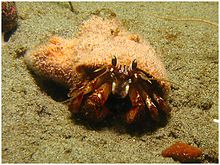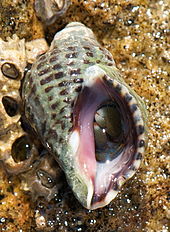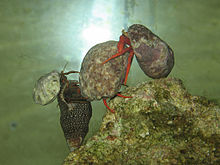- Hermit crab
-
Hermit crabs
Temporal range: 136–0 Ma
Pagurus armatus Scientific classification Kingdom: Animalia Phylum: Arthropoda Subphylum: Crustacea Class: Malacostraca Order: Decapoda Infraorder: Anomura Superfamily: Paguroidea
Latreille, 1802Families - Coenobitidae
- Diogenidae
- Paguridae
- Parapaguridae
- Pylochelidae
- Pylojacquesidae
Hermit crabs are decapod crustaceans of the superfamily Paguroidea.[1] Most of the 1100 species possess an asymmetrical abdomen which is concealed in an empty gastropod shell that is carried around by the hermit crab.
Contents
Description
Outside its shell, the soft, curved abdomen of hermit crabs such as Pagurus bernhardus is vulnerable.
Most species have long, spirally curved abdomens, which are soft, unlike the hard, calcified abdomens seen in related crustaceans. The vulnerable abdomen is protected from predators by a salvaged empty seashell carried by the hermit crab, into which its whole body can retract.[2] Most frequently hermit crabs use the shells of sea snails (although the shells of bivalves and scaphopods and even hollow pieces of wood and stone are used by some species).[3] The tip of the hermit crab's abdomen is adapted to clasp strongly onto the columella of the snail shell.[4]
As the hermit crab grows in size, it has to find a larger shell and abandon the previous one. This habit of living in a second hand shell gives rise to the popular name "hermit crab", by analogy to a hermit who lives alone.[5] Several hermit crab species, both terrestrial and marine, use "vacancy chains" to find new shells: when a new, bigger shell becomes available, hermit crabs gather around it and form a kind of queue from largest to smallest. When the largest crab moves into the new shell, the second biggest crab moves into the newly vacated shell, thereby making its previous shell available to the third crab, and so on.[6][7]
Most species are aquatic and live in varying depths of saltwater, from shallow reefs and shorelines to deep sea bottoms. Tropical areas host some terrestrial species, though even those have aquatic larvae and therefore need access to water for reproduction.
A few species do not use a "mobile home" and inhabit immobile structures left by polychaete worms, vermetid gastropods, corals and sponges.[3]
Biology
Shells and shell competition
 A hermit crab retracted into a shell of Acanthina punctulata and using its claws to block the entrance
A hermit crab retracted into a shell of Acanthina punctulata and using its claws to block the entrance
As hermit crabs grow they require larger shells. Since suitable intact gastropod shells are sometimes a limited resource, there is often vigorous competition among hermit crabs for shells. The availability of empty shells at any given place depends on the relative abundance of gastropods and hermit crabs, matched for size. An equally important issue is the population of organisms that prey upon gastropods and leave the shells intact.[8] Hermit crabs that are kept together may fight or kill a competitor to gain access to the shell they favor. However, if the crabs vary significantly in size, the occurrence of fights over empty shells will decrease or remain non-existent.[7]
A hermit crab with a shell that is too small cannot grow as fast as those with well-fitting shells, and is more likely to be eaten if it cannot retract completely into the shell.[9]
For some larger marine species, supporting one or more sea anemones on the shell can scare away predators. The sea anemone benefits, because it is in position to consume fragments of the hermit crab's meals.
Development and reproduction
Hermit crab species range in size and shape, from species with a carapace only a few millimetres long to Coenobita brevimanus, which can approach the size of a coconut. The shell-less hermit crab Birgus latro (coconut crab) is the world's largest terrestrial invertebrate.[10]
The young develop in stages, with the first two (the nauplius and protozoea) occurring inside the egg. Most hermit crab larvae hatch at the third stage, the zoea. This is a larval stage wherein the crab has several long spines, a long narrow abdomen, and large fringed antennae. After several zoeal moults, this is followed by the final larval stage, the megalopa stage.[11]
Classification
Hermit crabs are more closely related to squat lobsters and porcelain crabs than they are to true crabs. The king crabs in the family Lithodidae were formerly considered to be derived hermit crabs, but are now placed in a separate superfamily.[12]
Six families are recognised in the superfamily Paguroidea,[13] containing around 1100 species in total in 120 genera.[14]
- Coenobitidae Dana, 1851 – 2 genera: terrestrial hermit crabs and the coconut crab
- Diogenidae Ortmann, 1892 – 20 genera of "left-handed hermit crabs"
- Paguridae Latreille, 1802 – 76 genera
- Parapaguridae Smith, 1882 – 10 genera
- Pylochelidae Bate, 1888 – 10 genera of "symmetrical hermit crabs"
- Pylojacquesidae McLaughlin & Lemaitre, 2001 – 2 genera
Fossil record
The fossil record of in situ hermit crabs using gastropod shells stretches back to the Late Cretaceous. Before that time, at least some hermit crabs used ammonites' shells instead, as shown by a specimen of Palaeopagurus vandenengeli from the Speeton Clay, Yorkshire, UK from the Lower Cretaceous.[15]
As pets
Several marine species of hermit crabs are common in the marine aquarium trade. Of the approximately 15 terrestrial species in the world, the following are commonly kept as pets: Caribbean hermit crab (Coenobita clypeatus), Australian land hermit crab (Coenobita variabilis), and the Ecuadorian hermit crab (Coenobita compressus). Other species, such as Coenobita brevimanus, Coenobita rugosus, Coenobita perlatus or Coenobita cavipes, are less common but growing in availability and popularity as pets.
These omnivorous or herbivorous species can be useful in the household aquarium as scavengers, because they eat algae and debris.
Hermit crabs are often seen as a "throwaway pet" that would live only a few months, but species such as Coenobita clypeatus have a 23 year lifespan if properly treated,[16] and some have lived longer than 32 years.[17][18]
In general, and despite their moniker, hermit crabs are social animals that do best in groups.[19] In the wild they can be found in colonies of a hundred or more. Therefore, many sellers encourage the purchase of more than one crab.[20] They also require a temperature and humidity-controlled environment, and adequate substrate that is deep enough to allow them to completely bury themselves while moulting.
External links
 Media related to Paguroidea at Wikimedia Commons
Media related to Paguroidea at Wikimedia Commons Data related to Paguroidea at Wikispecies
Data related to Paguroidea at Wikispecies Animal Care/Land hermit crab at Wikibooks
Animal Care/Land hermit crab at Wikibooks
References
- ^ "Paguroidea". Integrated Taxonomic Information System. http://www.itis.gov/servlet/SingleRpt/SingleRpt?search_topic=TSN&search_value=345098. Retrieved August 12, 2006.
- ^ Ray W. Ingle (1997). "Hermit and stone crabs (Paguroidea)". Crayfishes, lobsters, and crabs of Europe: an illustrated guide to common and traded species. Cambridge University Press. pp. 83–98. ISBN 9780412710605. http://books.google.co.uk/books?id=x-qVGbTAOiEC&pg=PA83.
- ^ a b Jason D. Williams; John J. McDermott (2004). "Hermit crab biocoenoses: a worldwide review of the biodiversity and natural history of hermit crab associates" (PDF). Journal of Experimental Marine Biology and Ecology 305: 1–128. doi:10.1016/j.jembe.2004.02.020. http://people.hofstra.edu/jason_d_williams/Publications/Williams&McDermott2004%20copy.pdf.
- ^ W. D. Chapple (2002). "Mechanoreceptors innervating soft cuticle in the abdomen of the hermit crab, Pagurus pollicarus". Journal of Comparative Physiology A 188 (10): 753–766. doi:10.1007/s00359-002-0362-2. PMID 12466951.
- ^ Douglas Harper. "Hermit". Online Etymology Dictionary. http://www.etymonline.com/index.php?term=hermit. Retrieved March 26, 2010.
- ^ "Social networking helps hermit crabs find homes: previously unknown group behaviors lead to better housing for all". Tufts University. April 26, 2010. http://news.tufts.edu/releases/release.php?id=169.
- ^ a b Randi D. Rotjan, Jeffrey R. Chabot & Sara M. Lewis (2010). "Social context of shell acquisition in Coenobita clypeatus hermit crabs". Behavioral Ecology 21 (3): 639–646. doi:10.1093/beheco/arq027.
- ^ E. Tricarico & F. Gherardi (2006). "Shell acquisition by hermit crabs: which tactic is more efficient?". Behavioral Ecology and Sociobiology 60 (4): 492–500. doi:10.1007/s00265-006-0191-3.
- ^ J. E. Angel (2000). "Effects of shell fit on the biology of the hermit crab Pagurus longicarpus (Say)". Journal of Experimental Marine Biology and Ecology 243 (2): 169–184. doi:10.1016/S0022-0981(99)00119-7.
- ^ P. Grubb (1971). "Ecology of terrestrial decapod crustaceans on Aldabra". Philosophical Transactions of the Royal Society B 260 (836): 411–416. doi:10.1098/rstb.1971.0020. http://rstb.royalsocietypublishing.org/content/260/836/411.abstract.
- ^ H. J. Squires (1996). "Larvae of the hermit crab, Pagurus arcuatus, from the plankton (Crustacea, Decapoda)". Journal of Northwest Atlantic Fishery Science 18: 43–56. doi:10.2960/J.v18.a3. http://journal.nafo.int/J18/squires1.pdf.
- ^ Sammy De Grave, N. Dean Pentcheff, Shane T. Ahyong et al. (2009). "A classification of living and fossil genera of decapod crustaceans". Raffles Bulletin of Zoology Suppl. 21: 1–109. http://rmbr.nus.edu.sg/rbz/biblio/s21/s21rbz1-109.pdf.
- ^ Patsy McLaughlin & Michael Türkay (2010). "Paguroidea". In P. McLaughlin. World Paguroidea database. World Register of Marine Species. http://www.marinespecies.org/aphia.php?p=taxdetails&id=106687. Retrieved October 5, 2010.
- ^ Patsy A. McLaughlin, Tomoyuki Komai, Rafael Lemaitre & Dwi Listyo Rahayu (2010). Part I – Lithodoidea, Lomisoidea and Paguroidea. In Martyn E. Y. Low and S. H. Tan. "Annotated checklist of anomuran decapod crustaceans of the world (exclusive of the Kiwaoidea and families Chirostylidae and Galatheidae of the Galatheoidea)" (PDF). Zootaxa Suppl. 23: 5–107. http://rmbr.nus.edu.sg/rbz/biblio/s23/s23rbz005-107.pdf.
- ^ René H. Fraaije (2003). "The oldest in situ hermit crab from the Lower Cretaceous of Speeton, UK". Palaeontology 46 (1): 53–57. doi:10.1111/1475-4983.00286.
- ^ Land Hermit Crab Care Guide. Pet Smart. 2006. http://www.petsmart.com/uc/petarticles_db.jsp?ucCategory=CARE&ucTopic=FISH&ucSubTopic=CARE&ucSubTopic2=&ucContent=/articles/content/fish/care/hermit-crab/HermitCrabs.html.
- ^ Linda Lombardi (2008). "Hermit crabs can be fun, long-lasting pets". The Olympian (The Associated Press). http://www.theolympian.com/living/story/519995.html. Retrieved October 2008.
- ^ Stacy (2008). "How old is my hermit crab?". crabstreetjournal.com. http://crabstreetjournal.com/xoops/modules/news/article.php?storyid=16. Retrieved August 2008.
- ^ Christa Wilkin (2004). "Basic crab care". http://www.hermit-crabs.com/care.html. Retrieved August 2008.
- ^ Tammy Weick (2010). "The Hermit Crab Patch". http://www.hermitcrabpatch.com/Hermit-Crab-Friends-a/150.htm. Retrieved November 2010.
Categories:- Anomura
- Hermit crabs
- Pet crustaceans
Wikimedia Foundation. 2010.



